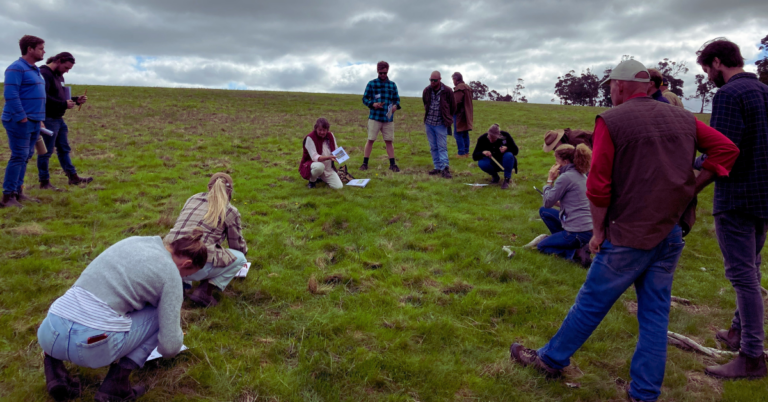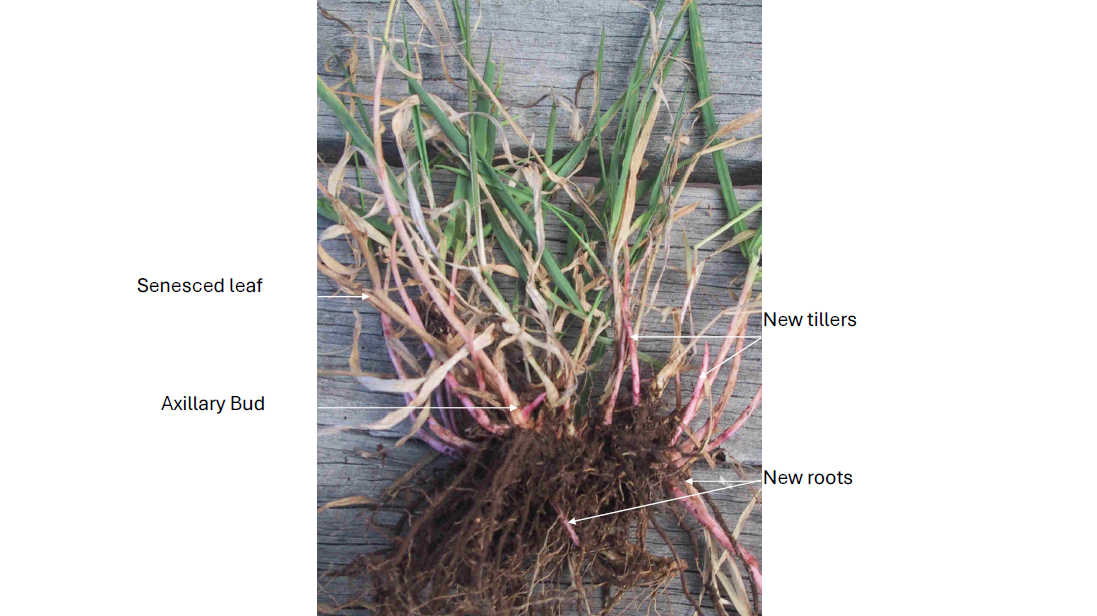
Dr Judi Earl (centre) talking grazing management and pasture productivity.
Encouraging farmers to move their livestock on while there is still available feed in the paddock is not an easy sell. But according to PhD pasture ecologist Dr Judi Earl, it’s an essential step in increasing the carrying capacity of your land.
Judi has spent more than 25 years working with farmers around Australia on grazing management for pasture productivity and she was in Margaret River recently sharing her expertise with participants in the Lower Blackwood Catchment Land Conservation District Committee’s Regenerative Agriculture in Practice Program (RAPP).
Our Sustainable Agriculture Facilitator (SAF) Karen Whitehead was there to gather up her key messages on grazing management for pasture productivity and share with those who were unable to attend.
The case for rotational grazing
Speaking about the importance of residual herbage and utilisation her catch phrase was: “Grow more; Use more; Leave more”.
Judi says if farmers leave more herbage mass in their paddocks after livestock have been through, they will end up with more feed over time, increasing the carrying capacity of their land.
To achieve this, Judi says farmers need to defer grazing until the pasture grows above 5-6cm and move animals on before it drops below this level.
“Lots of people look at the residual left and think you’re wasting a massive amount of feed but the thing is that for grasslands and pastures to function effectively there’s a whole lot of critters that you’re relying on, the soil biota, all the insects, the birds, the reptiles, they all need to be supported by that same grassland to feed into maintaining a healthy functioning ecosystem,” she said.
“Rather than wasting feed, what we are trying to promote is working in a higher plane in the pasture.”
Luckily, says Judi, it’s not a case of ecosystem health verses production. Instead, increasing pasture ecosystem health results in an increase in production.
“Instead of working from the ground level to 5-6cm, work between 6-12cm (i.e. graze to 6 cm),” she said.
“That’s all we’re doing. We’re not actually changing production; in fact, you start to increase production when you work in that higher plane over a period of time.”
Why it works
Judi doesn’t think it’s a coincidence that for cattle, their comfortable bite height is the optimal height to leave residual green leaf on pasture plants.
Grasses and grazers have evolved together. The size of the plant above the ground is generally a reflection of the size of the roots below the ground.
Grazing below 5cm results in a root loss as plants can’t photosynthesise enough energy to send sufficient exudates down due to the reduced photosynthetic area.
Maintaining optimal pasture height maintains healthy ecosystem function above ground so the root systems continue to feed soil microbiota and maintain porosity and soil structure below ground.
“The more you leave behind; the more protection you’re giving to those underground processes and the more roots you’re conserving which means more carbon is in the system and that builds capacity in the environment,” Judi said.
Using grazing management as a tool for encouraging desirable pasture species
Judi says: “This selective grazing is really important in structuring vegetation because they are able to select not only more desirable plants, but plant parts and species as well, which modifies the competition that goes on between plants in the pasture, generally in favour of the less palatable plants.”
In other words, livestock don’t leave the best for last.
To understand why returning for a second bite on a plant is detrimental we need to look at the structure of pasture plants.
Grasses grow from their tips in clusters of tillers. Allowing livestock to take a first bite then moving them on means plants can re-grow from the lower, younger growth tips.
It’s the second bite where the damage to pastures is done. If the livestock are given enough time to go back to their favourite plants in the one graze event the plant is grazed too low and the majority of the growth tips are munched, reducing its capacity for regrowth.
Take this photo of a Phalaris plant for example.

The pink coloured tillers are the new vegetative growth tips coming through.
If the livestock take their first bite off the top of the plant, they take the more mature leaf tips without affecting the younger tillers.
But if they are in the paddock long enough to return for a second bite, the new tillers are affected and the reproductive potential of that plant is compromised.
“The first 1-2cm in the growth tip is where the growth happens and if they’re damaged in the growing phase that means that that tiller dies,” Judi explained.
“A single perennial grass tiller can reproduce itself up to 15 times. But if you damage the leaf tip then that’s the end of that tiller.”
Judi’s take home messages
- If you manage livestock well, regeneration of land occurs, whereas managing livestock poorly degrades land.
- Grazing in the 12-6cm zone will increase production over time and contribute to increased ecosystem health.
- Livestock are selective grazers. The way they are managed across the landscape structures vegetation.
- Grasses grow from individual tiller tips and have the potential to produce up to 15 individual tillers in a season. Making sure livestock graze no lower than 5-6cm by preventing their second bite will result in best pasture utilisation and therefore maximum production potential.
You can find more information about Lower Blackwood’s RAPP project by visiting their website. They also have many past webinars with Judi Earl going into lots of detail on the topics discussed in this article.
Lower Blackwood Landcare also have an online community called Talkin’ After Hours which focuses on all things sustainable agriculture.
It is free to join and has been designed for South West landholders to share knowledge and experiences with each other in a no stress, judgement-free space.
For more information please follow this link to their website.
There’s still time to join a Grazing Matcher group. Phone Sustainable Agriculture Facilitator Karen Whitehead on 0427 806 193.
